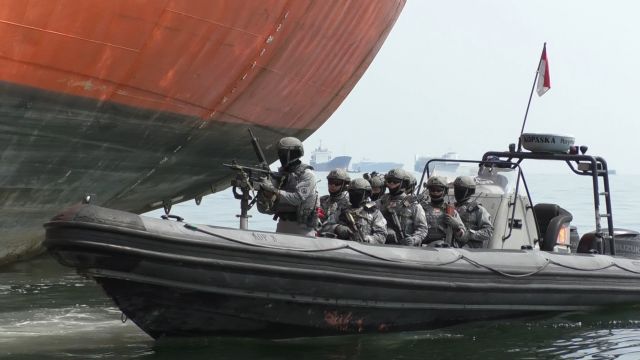A few months back, Japan pledged to aid the Indonesian Maritime Security Agency [IMSA or Bakamla]. The announcement unveiled Japan’s plan to donate a patrol boat to Indonesia to reinforce its maritime security. “Discussions about this grant, specifically regarding equipping IMSA with patrol boats, are still ongoing,” confirmed the Japanese foreign ministry on its official website towards the end of 2023.

This generous grant is especially advantageous for Indonesia, considering its vast Exclusive Economic Zone [EEZ]. “Indonesia boasts the third-largest exclusive economic zone globally, housing significant maritime transport routes like the Straits of Malacca.”
From Japan’s international logistics perspective, maintaining security in this region is paramount. However, “Regrettably, the institutions in Indonesia responsible for maritime security lack the necessary capacity,” voiced Japanese officials at the time.
The offender is… China
Given the prevailing sentiment in the region, both Indonesia and Japan view China as an interloper within Indonesia’s Exclusive Economic Zone [EEZ], which includes the Straits of Malacca. The strategic importance of the Malacca Strait for China, Japan, and indeed, the worldwide community, is indisputable.
From China’s perspective, the Malacca Strait is an integral segment of their trading routes. Consider the Malacca Strait as a nexus that connects the sea lanes of the Indian Ocean and the Pacific Ocean. Furthermore, this strait establishes an essential link between three of the largest countries in the world—Indonesia, India, and China.

In a report titled “China’s Triangular Diplomacy to Indonesia in Anticipation of the Malacca Dilemma in Belt Road Initiative,” published in The Journal of Social and Government, it’s estimated that the Straits of Malacca facilitates the passage of an impressive 50,000 ships each year. This accounts for a significant 20-25 percent of worldwide maritime trade. The magazine also hypothesizes potential conflicts that can occur in this area due to the strait’s notable importance.
Japan is interested
Japan is grappling with a significant concern, the Strait of Malacca. This crucial economic pathway, if unsettled, could destabilize Japan’s economy. In simple terms, any disruption in the importation of raw materials from Southeast Asia, including through the Straits of Malacca, would deliver a substantial economic blow to Japan.

A standout piece from UPN Veteran, titled “Japan’s Efforts to Maintain Security Stability in the Southeast Asia Region,” concisely explains the issue – sourcing raw materials from regions or countries other than Southeast Asia would noticeably inflate Japan’s import costs.
Given this backdrop, it’s not surprising that Japan has elected to donate a ship to IMSA. This gesture also suggests that IMSA could potentially garner support from the United States in the future.
The US got involved in the dilemma
Recently, Admiral TNI Dr. Irvansyah, S.H., M.Tr.Opsla, the Chief of IMSA, held a significant meeting with officials from the US Navy. To quote, “IMSA’s chief had a productive meeting with the Vice Chief of Naval Operations, Vice Admiral Eugene H. Black, at the prestigious Pentagon, located in Washington, United States,” as reported by IMSA on March 9, 2024.

The primary focus of the meeting was the escalating issue of maritime security. The key maritime zones targeted for discussion were Southeast Asia and the Indo-Pacific region. Furthermore, the US made efforts to foster enhanced security skills within IMSA.
The US warmly invited IMSA to participate in the highly esteemed maritime exercise, the Rim of the Pacific [RIMPAC]. “A cordial invitation from Eugene H. Black was extended to IMSA to be a part of the world’s largest international maritime exercise, RIMPAC,” IMSA excitedly shared on Instagram. The anticipation escalates as, according to many reports, RIMPAC 2024 is scheduled to take place in Hawaii, USA, this upcoming June.
The US is also interested

Similar to Japan, the United States also has stakes in the Indo-Pacific region. The US has been very clear about its ambitions – it is keen to cultivate an open and unrestricted Indo-Pacific region. As they’ve declared, “The global trajectory of the 21st century is increasingly being shaped and shifted within the Indo-Pacific region.”
In the last five years, the Indo-Pacific region has emerged as the fastest-growing economic area in the world, accounting for 60 percent of the global economic activity. Furthermore, our economy is heavily dependent on this region, receiving nearly one-third of our economic activities and attracting foreign investments worth over US$900 billion.
As articulated by the US Embassy in Indonesia, “Our goal is to foster an uninhibited and free Indo-Pacific”. However, the US perceives China as a potential hindrance to these plans, given China’s assertive claims over most of the South China Sea.

IMSA’s equipment
One of the most crucial assets in the IMSA arsenal is patrol vessels. These vessels are designed to monitor and control maritime activities and are equipped with advanced radar systems, communication devices, and weaponry for defensive purposes. IMSA also operates a fleet of fast attack crafts. These are smaller, more agile vessels, designed for quick response scenarios.
Another significant asset is the agency’s maritime surveillance aircraft. These aircraft are equipped with advanced radar and imaging systems, allowing them to monitor large areas of sea from the air. In addition to these, Bakamla also possesses unmanned aerial vehicles [UAVs] or drones. These drones can be used for a variety of tasks, including surveillance, reconnaissance, and even offensive operations.
Finally, the agency is equipped with a variety of smaller equipment such as high-speed rigid-hulled inflatable boats [RHIBs], which are used for boarding and inspection operations, and advanced communication and navigation systems, which are crucial for coordinating operations and ensuring the safety and effectiveness of their personnel.
***
Follow us everywhere and at any time. BulgarianMilitary.com has responsive design and you can open the page from any computer, mobile devices or web browsers. For more up-to-date news, follow our Google News, YouTube, Reddit, LinkedIn, Twitter and Facebook pages. Our standards: Manifesto & ethical principles.

